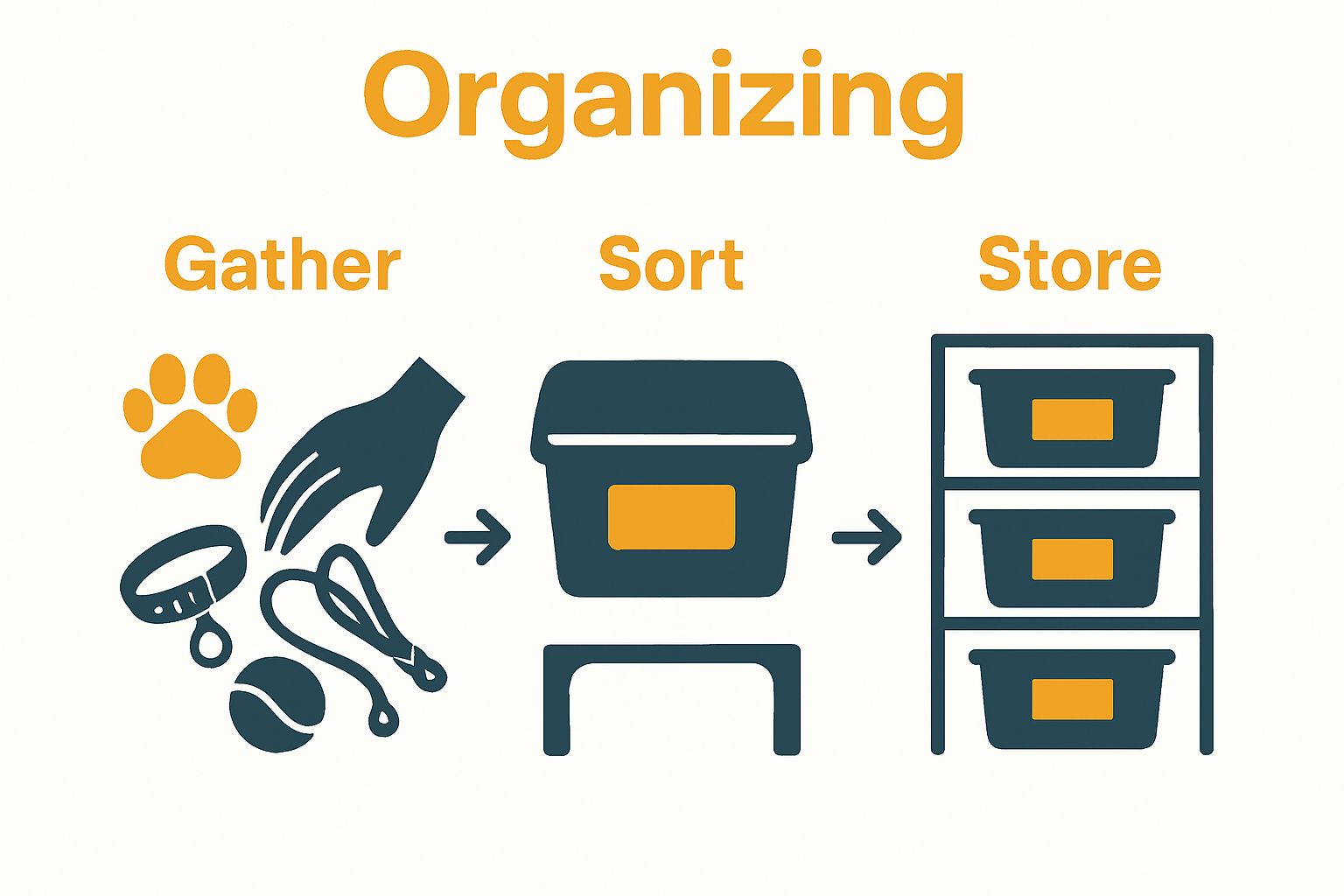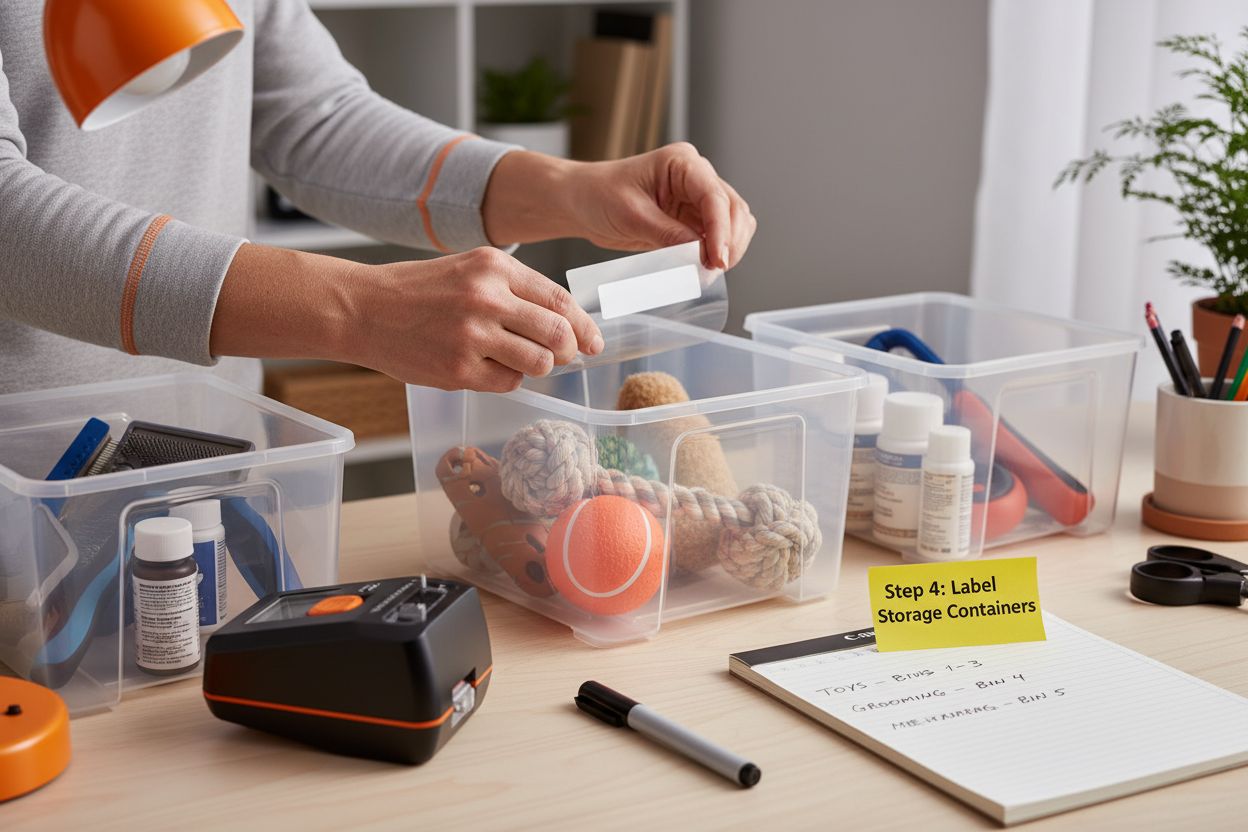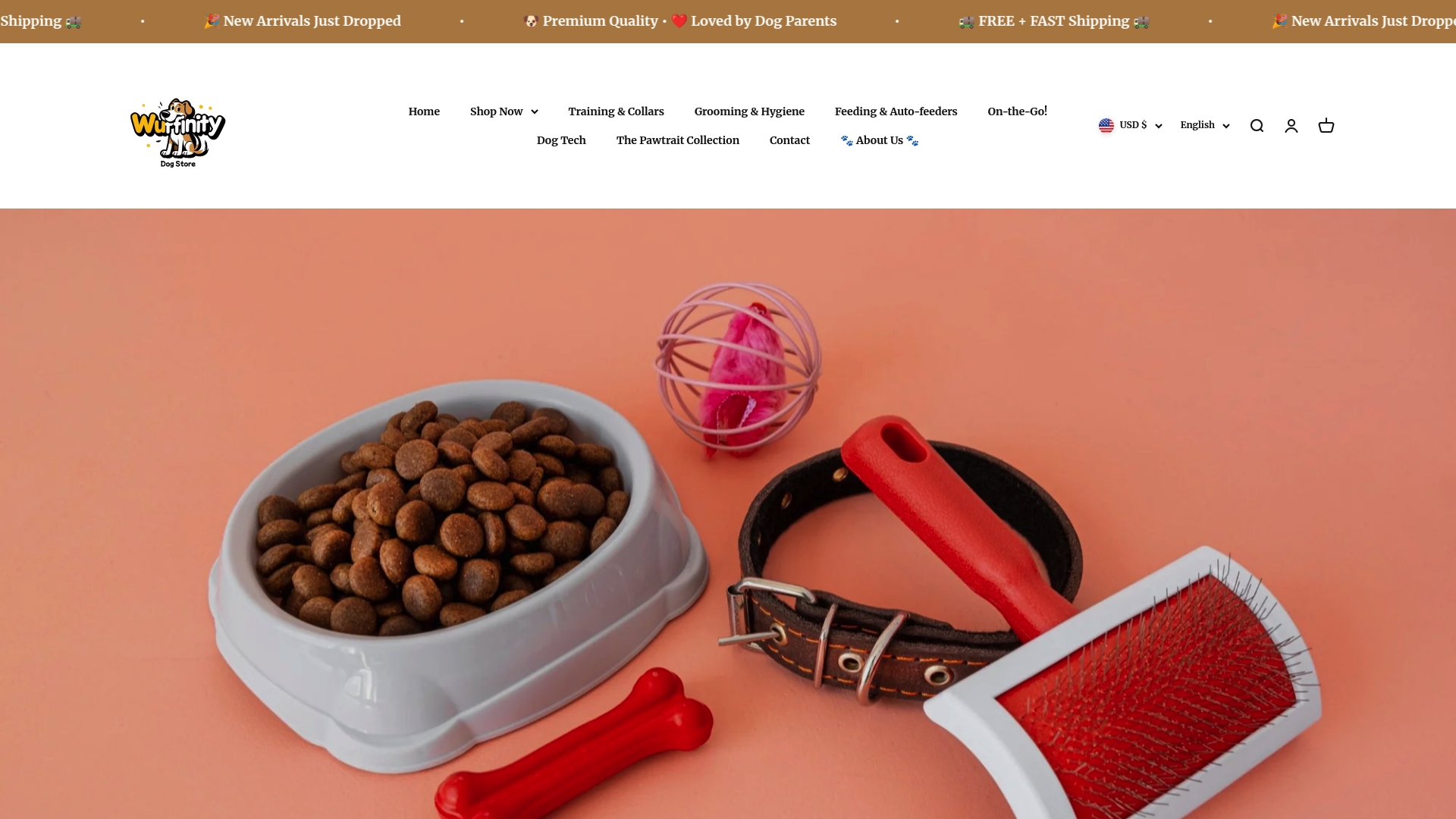Dog accessories have a way of taking over every corner of your home. From leashes to chew toys, the piles seem endless. Now check this. Most dog owners admit they can’t even name half of what they own for their pet. Surprising, right? Here is the real shocker. Storing and organizing your dog’s gear does not just clear clutter, it actually makes daily routines easier, slashes wasted time, and keeps your best friend safer.
Table of Contents
- Step 1: Collect And Categorize All Accessories
- Step 2: Choose The Right Storage Solutions
- Step 3: Organize Accessories By Usage Frequency
- Step 4: Label Storage Containers Clearly
- Step 5: Maintain Regular Updates And Assessments
Quick Summary
| Key Point | Explanation |
|---|---|
| 1. Collect and categorize dog accessories | Gather all items and sort them into clear categories to understand what you own and streamline your storage approach. |
| 2. Choose suitable storage solutions | Select containers and systems that protect your accessories, facilitate quick access, and fit your space aesthetic. |
| 3. Organize by frequency of use | Position frequently used items where they’re easily accessible while storing less-used accessories in more compact spaces. |
| 4. Label storage containers clearly | Use durable, legible labels to identify storage contents swiftly, simplifying access for all family members. |
| 5. Regularly assess and update your system | Schedule quarterly reviews to maintain organization, discard unusable items, and adjust your system to your dog’s evolving needs. |
Step 1: Collect and Categorize All Accessories
Organizing your dog accessories starts with a comprehensive collection and strategic categorization process. Before diving into storage solutions, you need a complete overview of everything you currently own. This initial step helps you understand the volume and types of accessories you have, which directly influences your storage approach.
Begin by gathering all dog accessories from around your home. Check every drawer, cabinet, closet, and storage area where items might be scattered. Pull out leashes, collars, harnesses, training tools, grooming supplies, toys, travel gear, and seasonal accessories. Spread these items on a large, clean surface like a table or floor where you can see everything at once.
As you collect your items, create clear categories that make sense for your specific needs. Typical categories might include walking gear (leashes, harnesses, tags), training equipment (clickers, treat pouches, training leads), grooming supplies (brushes, nail clippers, shampoos), health and medical items (first aid kit, medications), and recreational accessories (toys, chew items, outdoor play equipment).
While categorizing, take the opportunity to perform a quick inventory check. Discard any damaged or worn-out accessories that are no longer safe or functional. Replace frayed leashes, broken toys, or chewed harnesses. This process not only streamlines your collection but also ensures you maintain high-quality accessories for your dog.
Consider creating a simple tracking system as you categorize. A basic spreadsheet or notebook can help you log the quantity and condition of each accessory type. This documentation becomes invaluable when you want to track your dog’s gear, plan future purchases, or quickly identify what needs replacement.
Pro tip: Group accessories by frequency of use. Place daily items like walking gear and basic training tools in easily accessible categories, while storing seasonal or occasional items separately. This approach makes your storage system more intuitive and user-friendly.
By the end of this step, you should have a clear, organized overview of all your dog accessories, neatly sorted into logical categories and ready for the next stage of storage planning. A well-collected and categorized collection sets the foundation for an efficient and manageable dog accessory storage system.
The table below summarizes the main steps for organizing dog accessories, with key actions and intended outcomes for each stage.
| Step | Key Action | Intended Outcome |
|---|---|---|
| 1. Collect & Categorize | Gather all items and sort by type and usage | Clear overview of inventory and needs |
| 2. Choose Storage Solutions | Select suitable containers and systems | Protected, easy-to-access storage |
| 3. Organize by Frequency | Position items based on usage | Streamlined daily routines |
| 4. Label Clearly | Use durable, easy-to-read labels | Fast, intuitive retrieval by any household member |
| 5. Maintain & Update | Assess system quarterly and adjust as needed | Sustainable, clutter-free organization |

Step 2: Choose the Right Storage Solutions
Selecting appropriate storage solutions is crucial for maintaining an organized and accessible collection of dog accessories. The goal is to find containers, shelves, and systems that not only protect your gear but also make retrieval quick and easy. Your storage approach should balance functionality, durability, and convenience.
Start by evaluating the specific characteristics of your dog accessories. Different items require different storage considerations. Delicate grooming tools need protection from moisture and potential damage, while training equipment demands easy accessibility. Consider transparent, stackable containers with secure lids for smaller items like training treats, tags, and medical supplies. These containers allow you to see contents quickly and keep items dust free.
For larger accessories such as leashes, harnesses, and seasonal gear, invest in specialized storage solutions. Wall-mounted hooks provide an excellent organizational strategy for hanging leashes and harnesses, keeping them untangled and readily available. Over-the-door organizers with multiple pockets work wonderfully for storing training tools, grooming supplies, and smaller accessories. Look for options with reinforced stitching and water-resistant materials to ensure longevity.
Material selection matters significantly in dog accessory storage. Waterproof and washable storage options are ideal, considering the potential for dirt, mud, and pet-related wear. Plastic containers with tight-sealing lids protect against moisture and potential pest intrusion. Canvas or heavy-duty fabric storage cubes offer flexibility and can withstand regular cleaning, making them perfect for toys and outdoor gear.
Consider the visual and spatial dynamics of your storage area. Choose solutions that complement your home’s aesthetic while maximizing available space. Modular storage systems allow you to customize and expand your organization as your dog’s accessory collection grows. Corner shelves, under-bed storage containers, and dedicated closet organizers can transform otherwise unused spaces into efficient storage zones.
Prioritize accessibility when designing your storage strategy. Group frequently used items in lower, more easily reached containers or hooks. Seasonal or rarely used accessories can be stored in higher shelves or more compact, stackable containers. Label each storage section clearly to maintain your organizational system and help other family members quickly locate specific items.
By the end of this step, you should have a thoughtful, tailored storage solution that protects your dog accessories, makes them easy to find, and integrates seamlessly into your living space. The right storage approach transforms chaotic accessory collections into streamlined, manageable systems.
Here is a comparative overview of popular storage solutions for dog accessories, highlighting their main uses and specific advantages discussed in the article.
| Storage Solution | Ideal Use | Key Advantages |
|---|---|---|
| Transparent Stackable Containers | Small items, treats, medical supplies | Easy to view contents, protects from dust |
| Wall-Mounted Hooks | Leashes, harnesses, walking gear | Prevents tangling, quick access |
| Over-the-Door Organizers | Training tools, grooming supplies | Maximizes vertical space, multiple pockets |
| Plastic Storage Bins with Lids | Out-of-season or backup accessories | Moisture-proof, pest protection |
| Canvas/Fabric Cubes | Toys, flexible gear | Washable, durable, fits in closets |
Step 3: Organize Accessories by Usage Frequency
Organizing dog accessories by usage frequency transforms your storage system from a simple container collection into a highly functional, intuitive setup. This strategic approach ensures that the most frequently used items are always within easy reach, while less common accessories are neatly stored without cluttering your primary spaces.
Daily use accessories should be your primary focus when creating an organizational strategy. These typically include walking gear like leashes, harnesses, and basic training tools. Position these items in the most accessible locations such as near your home’s entrance, on wall-mounted hooks, or in a dedicated drawer close to where you typically prepare for dog walks. Consider using a compact, open-top container or wall organizer that allows for quick grabbing without complicated opening mechanisms.
For weekly or occasional accessories, create a secondary storage zone that is still convenient but not taking up prime real estate in your storage area. This might include items like different types of training equipment, specialized grooming tools, or seasonal outdoor gear. Stackable clear containers with labels work exceptionally well for these items. Place these containers on lower shelves or in a nearby closet where they are easily retrievable but not blocking access to daily essentials.
Seasonal and rarely used accessories require a different storage approach. Holiday costumes, specialized winter gear, or backup equipment can be stored in more compact, sealed containers and placed in less accessible areas like high shelves, under-bed storage, or garage storage units. Use vacuum-sealed bags for fabric items to protect them from dust and moisture, and ensure these containers are clearly labeled with contents and date of storage.
Create a visual mapping system for your accessories organization. This could be as simple as a small whiteboard near your storage area or a digital spreadsheet tracking where specific items are located. Color-coding containers or using distinct shelf sections can also help maintain your organizational system. For instance, use blue containers for walking gear, green for training tools, and red for medical supplies.
Remember that an effective organization system is dynamic. Schedule quarterly reviews of your dog accessory storage to reassess usage patterns, remove damaged items, and adjust your storage strategy. As your dog’s needs change with age, training progress, or lifestyle shifts, your storage system should evolve accordingly.
By the end of this step, you should have a thoughtfully arranged storage system that prioritizes accessibility, protects your accessories, and makes daily dog care routines smoother and more efficient. Your goal is a storage solution that feels intuitive and saves you time and frustration when preparing for walks, training sessions, or outdoor adventures.
Step 4: Label Storage Containers Clearly
Labeling transforms a basic storage system into an efficient, user-friendly organizational method. Clear, consistent labeling eliminates guesswork and saves precious time when searching for specific dog accessories. This step is about creating a logical, easy-to-understand system that works for everyone in your household.
Selecting the right labeling method is crucial for long-term success. Choose labels that are durable, water-resistant, and easy to read. Professional label makers provide crisp, uniform text and often include options for different label sizes and colors. However, if you prefer a more budget-friendly approach, invest in high-quality waterproof marker labels or printable adhesive labels that can withstand frequent handling and potential moisture.
Create a consistent labeling format that provides clear, concise information. Each label should include the category of accessories and potentially a brief description. For example, instead of simply writing “Toys,” be more specific: “Training Toys” or “Chew Toys Winter Collection.” This level of detail helps you quickly identify container contents without opening multiple storage units. Color-coding can add an extra layer of organization use different colored labels or markers for various accessory categories like blue for walking gear, green for training tools, and red for medical supplies.
Consider the placement and visibility of your labels. For transparent containers, place labels on the side that faces outward when stored. For opaque containers or shelving units, ensure labels are positioned at eye level and large enough to read quickly. If you have multiple family members or dog caregivers, create a small legend or reference guide that explains your labeling system, helping everyone maintain the organizational structure.
Digital complementation can enhance your physical labeling system. Create a corresponding digital spreadsheet or mobile app inventory that mirrors your physical labels. This backup ensures you have a record of your accessories even if physical labels become worn or damaged. Some smartphone apps allow you to scan labels and maintain a digital catalog of your dog’s gear, tracking item conditions and replacement needs.
Maintain your labeling system as a dynamic process. Schedule periodic reviews to update labels, remove outdated accessories, and adjust your organizational approach. As your dog’s needs change with age or training progress, your storage system should evolve accordingly. Flexibility is key to maintaining an effective accessory organization strategy.
By the end of this step, you should have a clearly labeled storage system that allows instant identification of accessories. Your labels should be durable, consistent, and intuitive, transforming your dog accessory storage from a potential source of frustration into a streamlined, easy-to-navigate solution. A well-labeled system saves time, reduces stress, and ensures you can quickly find exactly what you need for your furry companion.

Step 5: Maintain Regular Updates and Assessments
Maintaining an effective dog accessory storage system requires ongoing attention and periodic reassessment. This final step is about creating a sustainable organizational approach that adapts to your changing needs and ensures your storage solution remains functional and efficient over time.
Schedule quarterly review sessions to thoroughly evaluate your current storage system. Mark these assessments in your calendar as recurring events, treating them with the same importance as other essential home maintenance tasks. During these reviews, systematically examine each storage container, assess the condition of your accessories, and determine whether your current organization strategy still meets your dog’s evolving requirements.
During these assessments, conduct a comprehensive inventory check. Remove damaged or worn-out accessories that no longer serve their purpose. Training treats that have expired, leashes with frayed edges, or toys that have become unsafe should be discarded immediately. This process not only keeps your storage system clean but also ensures you’re maintaining high-quality gear for your dog.
Pay close attention to how your dog’s lifestyle and needs have changed. Puppies grow rapidly, and their accessory requirements transform dramatically within just a few months. A harness that fit perfectly six months ago might now be too small. Training tools that were essential during initial obedience classes might become less relevant as your dog advances. Your storage system should reflect these transitions, with containers and organization strategies that accommodate your dog’s current stage of life.
Digital tracking can significantly enhance your maintenance process. Consider creating a simple spreadsheet or using a mobile app to log accessory details such as purchase dates, condition, replacement needs, and frequency of use. Some pet management apps offer inventory tracking features that can help you monitor your dog’s gear more systematically. These digital tools provide a backup reference and help you make informed decisions during your quarterly assessments.
Encourage family involvement in maintaining the storage system. Create a shared understanding of the organizational approach, ensuring everyone knows where items belong and how to return them after use. Consider creating a simple guide or chart that explains the storage system, making it easy for other family members or pet sitters to maintain the established order.
Remember that flexibility is key. What works perfectly today might need adjustment in six months. Be prepared to modify your storage solutions, add new containers, or redesign your approach as your dog’s needs change. An adaptable system prevents organizational frustration and ensures your accessories remain accessible, protected, and ready for use.
By the end of this step, you should have established a dynamic, sustainable approach to managing your dog’s accessories. Your storage system is no longer a static arrangement but a living, evolving solution that grows and changes alongside your furry companion.
Tired of Cluttered Dog Accessories? Discover Functional Solutions at Wuffinity
Does your entryway or closet feel overrun by tangled leashes, scattered toys, and mixed-up grooming tools? The article above shows why proper storage and categorization matter for dog owners who value both convenience and safety. Imagine a setup where every item — from harnesses to treat pouches — has its logical place, making daily routines smooth and stress-free, just as the article recommends.

Take action today and turn your organization plans into reality. Explore curated storage and accessory solutions at Wuffinity.store, where you will find premium collars, leashes, grooming kits, and travel gear designed to fit your organized lifestyle. Our easy-to-browse shop helps you find exactly what you need for each storage category. Make your dog’s essentials easy to find while keeping your home neat. Visit Wuffinity.store now and experience a more organized, enjoyable life with your pet.
Frequently Asked Questions
How do I categorize my dog accessories for storage?
Begin by gathering all your dog accessories and create clear categories such as walking gear, training equipment, grooming supplies, health items, and recreational accessories. This helps streamline your organization process.
What type of storage solutions are best for dog accessories?
Consider using transparent, stackable containers for smaller items, wall-mounted hooks for leashes and harnesses, and over-the-door organizers for training tools and grooming supplies. Material selection should focus on durability and cleanliness, opting for waterproof and washable options.
How can I organize dog accessories based on usage frequency?
Prioritize daily use accessories by keeping them in easy-to-access locations, while stacking or boxing less frequently used items for secondary storage. Seasonal and rarely used accessories can be stored in high or less accessible areas, such as high shelves or under the bed.
Why is labeling important in organizing dog accessories?
Labels help to clearly identify the contents of each storage container, reducing search time and eliminating confusion. Using durable, easy-to-read labels allows anyone in your household to quickly find what they need without disrupting the organization system.






0 comments